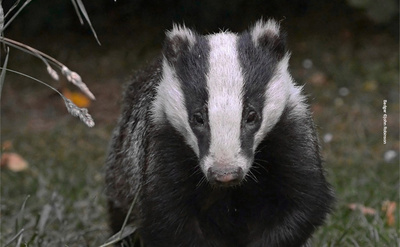The Ecology of the European badger (Meles meles) in Ireland - a review [Photo: ©Andrew Kelly]



Female |
Male |
|---|---|
| Length 90cm; Weight 10-11kg | Length 90cm; Weight 10-11kg |
Photo: ©Andrew Kelly

There is a continuing debate about the origin of badgers in Ireland, with the possibility of the species having been introduced by early settlers in the Neolithic period.
Genetic studies suggest that the Irish badger population are more closely related to badgers in Spain and Scandinavia rather than with those of Britain and central Europe.
Photo: ©John Robinson

Badgers are found throughout Ireland. However, despite their distribution, badgers are rarely seen in the wild due to their secretive and nocturnal behaviour. The most recent estimates suggest a population of around 100,000 badgers on the island of Ireland, and they are not considered endangered.
Badgers are protected under the Wildlife Acts (Wildlife Act, 1976; Wildlife Amendment Act, 2000), and in Northern Ireland under the Wildlife (N.I.) Order of 1985. It is also protected under Appendix III of the Berne Convention. Beyond Ireland, the European badger is found across western and central Europe.

The badger is Ireland’s largest mustelid, easily identified by its distinctive white head with two black stripes extending from the muzzle to the ears.
Badgers are of a stocky build, a small head, a short, thick neck, muscular legs and a bushy tail. While its fur is black and white, it often appears grey from a distance.
The Irish countryside provides ideal conditions for badgers, with its mix of pasture grasslands, hedgerows, scrub, and woodland. However, badger populations are less dense in upland, mountainous, and boggy areas and marginal pasturelands.
Unlike other members of the mustelid family, such as otters, stoats, pine martens, ferrets, and American minks, the badger is highly social. It lives in small groups, or clans, within burrow systems called setts. Each clan defends a territory that includes a variety of habitats, ensuring access to shelter and food throughout the year.
Badgers mark their territorial boundaries with faeces at latrine sites and well-marked boundary paths. Research across several Irish counties has shown that territory size varies greatly, ranging from 15 to nearly 300 hectares, with an average of about 80 hectares.
Badgers are expert diggers and almost always excavate their own setts. In Ireland, these are mainly found in hedgerows, scrub, and woodlands. Each badger group has multiple setts within its territory, but the 'main' sett serves as the central hub, typically occupied year-round and used for breeding. An active main sett is identified by well-used paths, bedding material, latrine sites, and often numerous entrances leading to an extensive underground tunnel system. Some main setts occasionally just have one or two entrances, but typically, there are numerous. Other setts within a group’s territory are usually smaller and only used intermittently or seasonally.
Badger groups vary in size, sometimes exceeding ten individuals, though they typically consist of two to six members, usually led by a dominant male and female. While badgers generally live in mixed-sex social groups, single-sex groups can occur, and in less favourable habitats, some badgers may live solitary lives.
Badgers are omnivores, feeding on a wide range of plants and animals. Their diet is dominated by crane fly larvae (leatherjackets), moth larvae, earthworms, wasps, bees, and frogs.
As opportunistic feeders, they also consume a wide range of invertebrates, small mammals and birds, carrion, and various plant-based foods such as fruits, berries, cereals, fungi, and roots.
They rely on a keen sense of smell and hearing to locate food, as their eyesight is well-adapted to low light but poor over long distances. A badger group’s territory typically includes diverse habitats to ensure food availability throughout the year, especially when certain prey, like earthworms, become scarce. In autumn, they feed heavily to build up fat reserves for the winter months.
Badgers can mate at any time of year, but most breeding occurs between February and May. During this period, male badgers become more territorial and aggressive, often engaging in fierce fights with rivals, which can lead to injuries.
After mating, fertilized embryos do not begin developing until late winter, a process known as delayed implantation. Once pregnancy begins, the gestation period lasts about two months, with cubs born between mid-January and mid-March. Litters usually consist of two to three cubs, though they can range from one to five.
Newborn cubs stay underground for around eight weeks, nursing for up to three months before emerging in late April or May. They remain dependent on their mother for about four months and may even stay with her through the winter. Male badgers reach maturity by their second year, while females can breed as early as their first year. However, survival rates for cubs are low, and while badgers can live up to 14 years, most in the wild do not survive beyond six years.
Badgers in Ireland have faced a history of persecution, including the practice of badger-baiting, which, though illegal, still occurs.
They are also threatened by illegal snaring and the disturbance of their setts. Additionally, road accidents are a significant cause of badger deaths and can lead to local population declines.
